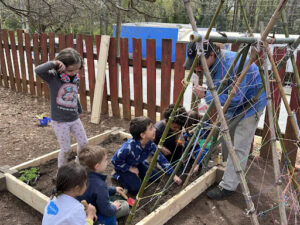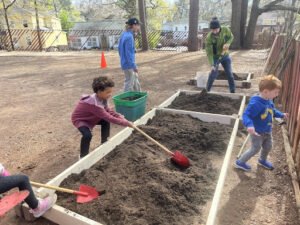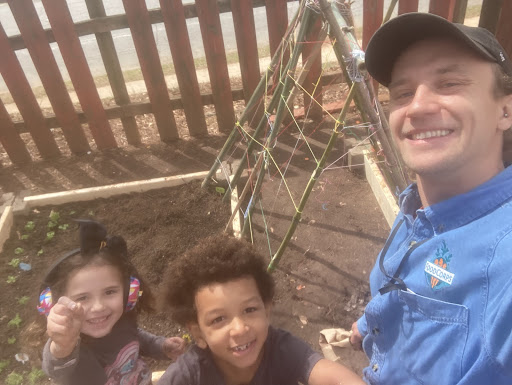by Ernie Stedman, FoodCorps Service Member at Wylde Center
From science and math to mental and physical health and the whole spectrum of social-emotional learning, there is a huge opportunity for kids to learn in a school garden. And you don’t need to be the most experienced gardener to do it!
Building a garden at your school can be really simple too. Let’s look at our checklist:
#1: Choose an area that gets plenty of SUNLIGHT!
A lot of our favorite plants to grow and harvest (strawberries, tomatoes, cucumbers, peppers, corn, squash) require full sunlight for 6-8 hours a day. If you don’t have an area with full sun, you can still have a garden, you will just be a little more limited on what you can grow. Greens, herbs, and root veggies still do well in the shade.
#2: Secure materials for the garden beds
There are many ways to build garden beds. You can make them out of cinder blocks or wood, you can make them short or tall, and you can make them square or rectangular. I chose a design based on low cost and easy assembly so that students could help me put it together. Here’s the materials list and plan I used. My garden area isn’t the biggest, but the wood, concrete blocks, and soil all together only cost about $200
Materials
-
-
- (10) Concrete planter wall blocks (available at Home Depot and Lowe’s)
- (2) 8 foot long 2×6 untreated lumber
- (9) 2×6 untreated lumber
- (12) 2 cubic ft bags of soil (I used an online soil calculator to see how much I needed)
- Bamboo & colorful twine to create your own trellis
-
For the trellis, I harvested some bamboo from my neighborhood and then we tied it together with twine and used colorful string to make ladder steps for the plants to climb up.

#3: Compost, seeds, and transplants
It’s a great idea to amend your soil, or add compost or other organic fertilizers when you install them. It’s a great opportunity to teach a lesson on worms or the nutrient cycle and ways we can dispose of our waste. Then once you’ve mixed it all together you can sow seeds or transplant some little plants. Or wait til class time for any of these steps and base a lesson around it!

Side notes and additional tips:
If you’re building your garden beds on top of an overgrown or grassy area, you can place cardboard boxes on top of those things before you fill your bed frames with soil. The plants will die and decompose and the cardboard will decompose, making it a little easier.

